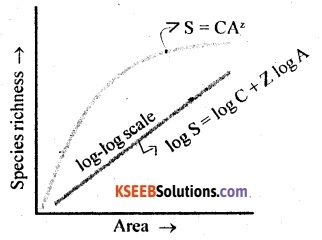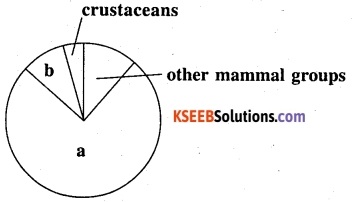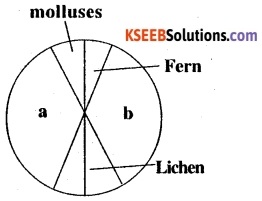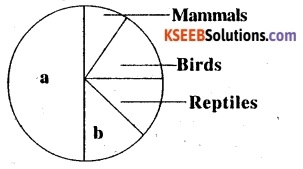You can Download Chapter 15 Biodiversity and Conservation Questions and Answers, 2nd PUC Biology Question Bank with Answers, Karnataka State Board Solutions help you to revise complete Syllabus and score more marks in your examinations.
Karnataka 2nd PUC Biology Question Bank Chapter 15 Biodiversity and Conservation
2nd PUC Biology Biodiversity and Conservation NCERT Text Book Questions and Answers
Question 1.
Name the three important components of biodiversity.
Answer:
(i) Genetic biodiversity
(ii) Species diversity
(iii) Ecological diversity

Question 2.
How do ecologists estimate the total number of species present in the world?
Answer:
Total number of species is estimated by:
- Rate of discovery of new species
- Determination of species richness is an area.
Question 3.
Give three hypotheses for explaining why tropics show greatest levels of species richness.
Answer:
In tropics:-
- No Catastrophes – In tropics, there has been no catastrophes but is temperate areas glaciations and other catastrophes have caused large scale of destruction.
- Non-seasonal Environment – In tropics, seasons are nearly uniform. It promotes rich and increases species diversity.
- Solar Energy – Tropics get lots of sunlight which enhances productivity.
Question 4.
What is the significance of the slope of regression in a species-area relationship?
Answer:
Slope of regression/regression co-efficient of species-area relationship indicates that species richness decreases with decrease in area.

- Regression coefficient is between 0.1 – 0.2 regardless of taxonomic group or region, eg: Plants in Britain, Birds is California.
- But in large areas like continents value is eg:- Frugivorous birds, mammals is tropical forests.
Question 5.
What are the major causes of species losses in a geographical region?
Answer:
Habits loss, Hunting, Habital fragmentation, Forest fires. Alien species, Co extinction, Pollutions/Disturbance, Intensive agriculture, etc.
Question 6.
How is biodiversity important for ecosystem functioning?
Answer:
- Biodiversity is important for productivity, stability, resilience and health of ecosystems.
- Biodiversity is important not only for ecosystem function but also for very survival of human race on earth.
Question 7.
What are sacred groves? What is their role in conservation?
Answer:
- Sacred grooves are places of worship where their exploitation or destruction is not allowed by worshipers. eg: Kumaon areas, Khasi hills (Meghalaya), Aravalli hills (Rajasthan), Western ghats (Kerala, Karnataka).
- They are the last refuges for a large number of rare and threatened plants and species only because of its freedom from exploitation.
![]()
Question 8.
Among the ecosystem services are control of floods and soil erosion. How is this achieved by the biotic components of the ecosystem?
Answer:
Ecosystem services regulate and protects ecosystem that are essential for maintaining climate and ecology of area.
Control of soil erosion
- Plant roots hold soil particles firmly.
- Plant cover protects soil from erosion by wind and water.
- Plants increases porosity and fertility of the soil.
Control of floods It is carried by retention of water and prevention of runoff. Litter and humus of plants acts as sponge to retain rainwater. Plants hold soil, so prevents soil erosion. Rainwater does not run – off, so prevents flood as they filter water into soil.
Question 9.
The species diversity of plants (22%) is much less than that of animals (72%). Give explanation.
Answer:
- Plants are fixed and need fewer adaptations and little competition to obtain optimum raw materials and sunlight. So little diversity.
- But in Animals, they are mobile, they converge on single piece of vegetation, so comes competition that leads to species variation, so has more diversity in animals.
Question 10.
Can you think of a situation where we deliberately want to make a species extinct? How would you justify it?
Answer:
Some species are harmful to human eg: HIV, Small pox vires etc. Such species are not part of any food chains or webs. So, their extinction will not effect ecosystem. And also their extinction can be beneficial to humans. eg:- HIV, small pox vires, plasmodium species etc.
2nd PUC Biology Biodiversity and Conservation Additional Questions and Answers
2nd PUC Biology Biodiversity and Conservation One Mark Question
Question 1.
What are endemic species?
Answer:
Those species which are confined to a particular region and are not found anywhere in the world are called endemic species.
Question 2.
Define biodiversity?
Answer:
The totality of genes, species and ecosystem of a given region i.e. the combined diversity at all the levels of biological organisation is called biodiversity.
Question 3.
Name some biodiversity hotspots in India
Answer:
Western Ghats, Himalayas, Indo-Burma region – Srilanka.
Question 4.
Which are three important components of biodiversity ?
Answer:
The three components or levels of biodiversity are
- Genetic diversity
- Species diversity and
- Ecological diversity. Ecological diversity has again 3 components – alpha diversity (with in community diversity), beta diversity (between community diversity) and gamma diversity (regional diversity).
Question 5.
Amazon rain forest has the greatest biodiversity on earth. List any two hypothesis that are proposed by the biologists to account for the greater biological diversity.
Answer:
In tropics:-
- No Catastrophes – In tropics, there has been no catastrophes but is temperate areas glaciations and other catastrophes have caused large scale of destruction.
- Non-seasonal Environment – In tropics, seasons are nearly uniform. It promotes rich and increases species diversity.
- Solar Energy – Tropics get lots of sunlight which enhances productivity.
Question 6.
In the pie chart (A) and (B) drawn below to show the global animal diversity, which groups of animals would you name and write on the areas shaded black in (A) and (B). In which kind of habitat would you find these groups of animals
Answer:
(A) Insects Habitat, Mostly terrestrial
(B) Fishes Habitat, Aquatic.
Question 7.
What’s species diversity?
Answer:
The variety of species within a given region is called the species diversity.
Question 8.
Name the unlabeled areas ‘a’ and ‘b’ of the pie chart representing the global diversity of invertebrates showing their proportionate number of species of major taxa (Delhi 2009)

Answer:
(a) Insects
(b) Molluscs
![]()
Question 9.
Name the unlabeled areas ‘a’ and ‘b’ of the pie chart representing the biodiversity of plants showing their proportionate number of species of major taxa. (AI2009)

Answer:
(a) Fungi
(b) Angiosperms.
Question 10.
Name the unlabeled areas ‘a’ and ‘b’ of the pie chart representing the biodiversity of vertebrates showing the proportionate number of species of major taxa. (CBSE 2009)

Answer:
(a) Fishes
(b) Amphibians.
Question 11.
Name 2 animals that have become extinct by over exploitation by humans.
Answer:
Steller’s sea cow and passenger pigeon.
2nd PUC Biology Biodiversity and Conservation Two Marks Questions
Question 1.
Write the scientific name of the plant that yields reserpine. How is genetic variation expressed in this plant?
Answer:
- Rauwolfia vomitoria is the plant that yields reserpine.
- The genetic variation is shown in terms of the potency and concentration of the active chemical reserpine.
![]()
Question 2.
What does the term genetic diversity refer to? What is the significance of large genetic diversity in population?
Answer:
The term genetic diversity refers to the diversity of genes within a species.
It is important because
- Greater the genetic diversity among the organisms of a species, more sustenance, has against environmental perturbations.
- Genetically uniform populations are highly prone to diseases and harsh environment.
Question 3.
Explain co-extinction.
Answer:
It is a phenomenon in which when a species becomes extinct, the plant and animal species associated with an obligatory manner also become extinct. eg:- When a host fish becomes extinct, its unique assemblage of parasites also faces extinction.
Question 4.
Differentiate between zoological and national parks
Answer:
| Zoological park | National park |
| These are the areas where the threatened animals are kept under conditions very similar to their natural habitat. | These are large areas where animals and plants are protected in their natural habitat. |
| It is an exsitu method os conservation. | It is an insitu conservation method. |
Question 5.
What are biosphere reserves? How many of them are present in India?
Answer:
Biosphere reserves are the ecologically unique and bio-diversity rich regions that are legally protected. There are 14 biosphere reserves in India.
Question 6.
Why does the introduction of alien species into an ecosystem cause loss of biodiversity.
Answer:
The alien species become invasive and resources, so there is a decline in the indigenous species.
Question 7.
Name the region of the earth called the “lungs of the planet”. Mention giving reasons, the activities which are being carried out in this region now.
Answer:
Amazon forest is called the “lungs of the planet”. Human activities which are being carried out in this region are
- Grazing of beef cattle
- Cultivation of soya bean crop.
Question 8.
When and where the convention on biological diversity (earth summit) was held? While its aim.
Answer:
- The earth summit was held in Rio de Janeiro in 1992.
- The aim was to make the nation to take appropriate measures for conservation of biodiversity and sustainable utilization of its benefits.
Question 9.
What are sacred groves? Where are they found in India?
Answer:
Sacred groves are the tracts of forests that are set a side where all the trees and wild life are venerated and given a complete protection.
In India sacred grooves are found in
- Kashi and Jaintia Hills in Meghalaya
- Aravalli hills of Rajasthan
- Western Ghat regions of Karnataka and Maharashtra.
- Sarguja, Chanda and Bastar areas of M.R
- Sarpakavu of Kerala.
![]()
Question 10.
Name the following
(a) The group of animals that is maximum among vertebrates
(b) The scientist who coined the term biodiversity
(c) the lungs of the planet earth
(d) The region in India where maximum number of amphibians are present.
(e) The most species rich taxonomic group of animals.
Answer:
(a) Fishes
(b) Edward Wilson
(c) Amazon forest
(d) Western ghat
(e) Insect.
2nd PUC Biology Biodiversity and Conservation Three Marks Questions
Question 1.
Differentiate between In situ conservation and Ex situ conservation.
Answer:
In situ conservation:- It is the method of protecting the endangered species of plants or animals in the natural habitat either by protecting or cleaning up the habitat itself or by defending the species from predators.
- It helps in recovering populations in the surroundings where they have developed their distinct features.
Ex situ conservation :-
- It is the method of protecting the endangered species of plants or animals by removing them from the unsafe or threatened habitat and placing under the care of humans.
- It helps in recovering or preventing their extinction under stimulated conditions.
Question 2.
What are the characteristics of a stable community?
Answer:
- A stable community does not show much of variation in productivity from year to year.
- Such a community must be either resistant or resilient to occasional disturbances both natural and man made.
- It must be resistant to invasions by alien species.
Question 3.
Differentiate between Genetic diversity and species diversity.
Answer:
| Genetic diversity | Species diversity |
| (a) It is trait of the organisms. (b) It represents the variety of genetic informations present in the organisms. (c) It is important for adaptation to environment and changes occurring in it. |
(a) It is trait of the biotic community. (b) It is variety of species and their abundance found within a region. (c) It influences the stability of the ecosystem. |
2nd PUC Biology Biodiversity and Conservation Five Marks Question
Question 1.
What is the influence of biodiversity on the ecosystem? Mention the 3 possible consequences that loss of biodiversity in region can lead to.
Answer:
Influences of biodiversity
- The ecosystems with more species diversity show less year to year variation in total biomass production.
- The ecosystem with species diversity show more productivity compared to these with less species diversity.
Consequences are
The loss of biodiversity can lead to
- A decline in the crop productivity
- An increased variability in certain ecosystem
- A decreased resistance to environmental perturbates like drought.
Question 2.
How is the ‘sixth episode of extinction ‘of species on earth now currently in progress different from the five earlier episodes? Explain the various causes that have brought about this difference.
Answer:
Five episode of mass extinction have occurred during the past geological history of the earth due to natural phenomena like a continental draft, ice age, hitting of large
asteroids, global warming etc. But the sixth episode of mass extinction is due to human activities by knowingly or unknowingly ie. it is anthropogenic in origin, eg:- Destruction of tropical forests leads to destroy 14000-40000 species every year or 295% of species every hour.
Causes of these extinction may be.
- Habitat loss
- Habitat fragmentation
- Over exploitation of natural resources
- Introduction of alien species or exotic species which invade maximum space.
- Pollution due to human activity
- Commercial forestry.
![]()
Question 3.
Who proposed the rivet popper hypothesis? Explain the same with reference to ecosystem.
Answer:
This hypothesis was proposed by Paul Ehrlich.
- In an airplanes (ecosystems), all parts are joined together by using thousands of rivets (species).
- If every passenger travelling in this ecosystems causes the extinction of atleast one species (starts popping a rivet to take home), it may not be safer but if more and more rivets are removed, the plane becomes dangerously weak over a period of time.
- Further which rivet is removed may also be critical, loss of those on the wings is obviously a series threat to flight safety than those of a few on the seats or windows.
- Similarly, loss of key species, which run the ecosystem properly, is obviously a more serious threat to the ecosystem than other species.
Question 4.
Describe different methods of Ex-situ conservation
Answer:
In ex – situ conservation the threatened species of plants and animals are taken out of their natural habitat and placed in special settings where they can be protected and given special care.
(1) Zoological parks – The places where many animals that have become extinct in the wild, continue to be maintained.
(2) Botanical gardens – The place where many endangered and threatened species of plants are kept. It allows other plants which are used for reference or project purposes. In India there are 35 botanical gardens.
(3) Cryopreservation – It is the storage of materials at ultra low temperature of -196°C either by rapid cooling or by gradual cooling and simultaneous dehydration at low temperature.
(4) Tissue culture and micro propagation – This method is used for preserving the germplasm and growing a number of plants from small parts of organs.
(5) Seed banks – Seeds of different genetic varieties of commercially important plants can be kept for long periods.
![]()
Question 5.
Which are the different “methods of in situ conservation?
Answer:
In situ conservation is the process of protecting the whole ecosystem and its biodiversity at all levels.
The endangered species of plants and animals are protected in their natural habitat without disturbing them from their own habitat. It helps in recovering the population in the surroundings where they have developed their distinctive features.
- Hotspots -These are the regions with high levels of species richness and high degree of endemism to provide maximum protection.
- Biosphere reserves – These are ecologically unique and biodiversity rich regions that are legally protected. In India there are 14 biosphere reserves.
- National park and wild life sanctuaries- These are the places where animals are in
their own undisturbed habitat but protected these areas by law.
In India there are 90 national parks and 448 wild life sanctuaries are there. - Sacred groves – These are some patches of forest where all the trees and wild life with in are venerated and given total protection, eg: Sarpakavu in Kerala. Sarguja area of M.P. etc.